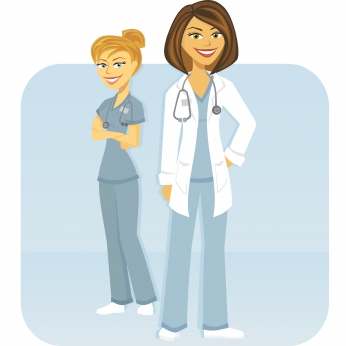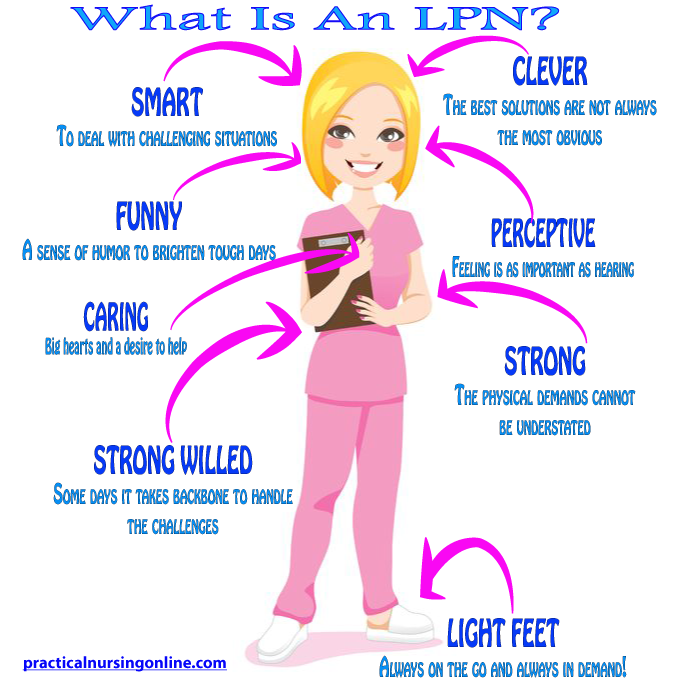Have you ever wondered “what is an LPN?” Well, for starters, a Licensed Practical Nurse (LPN) is a critical part of any health care team. LPNs are relied on to care for their patients using the best in judgment, skill, understanding, and knowledge of learned medical training (generally acquired through conventional or online LPN programs).
 The practical nurse is, furthermore, responsible for most direct patient health care. They are the intermediate between the doctor or RN, and the patient. The LPN will participate in the planning, implementation, and evaluation of nursing care, and they are also responsible for the psychological and emotional well-being of their patients.
The practical nurse is, furthermore, responsible for most direct patient health care. They are the intermediate between the doctor or RN, and the patient. The LPN will participate in the planning, implementation, and evaluation of nursing care, and they are also responsible for the psychological and emotional well-being of their patients.
Depending on the area of specialty, an LPN job description can range from basic care, to very specialized care. Licensed Practical Nurses are utilized in many areas of health care including: clinics, doctors’ offices, nursing homes, hospitals, rehabilitation centers, schools, and home health care. Most LPNs work an eight-hour shift, however, twelve-hour shifts are not unusual in this field of work.
What is an LPN? – A Typical Workday
Pre-Shift Routine
Upon arrival at the health care facility, the practical nurse checks-in with the nurse previously on duty. The nurse from the previous shift will bring the next nurse up to speed. They will exchange any special information or instructions regarding the patients they are caring for, which will help them plan the shift by determining which patients need more attention.
Making Rounds
Because of the personal nature of this profession, it is very important that the nurse make contact with his or her patients at the beginning of a shift. At this time, they can check on all patients, say hello and ask how they are feeling. Shortly after greeting patients they will meet with the RN or doctor who will brief them on changes since their last shift.
Helping with Everyday Needs
Much of the LPN’s job is to help with everyday needs of the patient. Some patients need the most basic of care such as bathing, eating, and changing clothes. At in-home care and nursing homes an LPN must have compassion and the drive to nurture their charges. This will help with the repetitive nature of personalized care.
Specialized Medical Procedures and Charts
A practical nurse is trained to perform a wide range of medical procedures depending on the patient’s needs. These specialized procedures may include inserting a catheter, dressing a wound, drawing blood for tests, or simply administering medication. With this type of work, an LPN can expect no two days to be the same as the needs of their patients are always changing. A large portion of the typical day is consumed with monitoring charts and using the time in-between to check on patients and review paperwork.
End of Shift
The end of the shift is much like the beginning – a meeting with the next shift LPN. During their meeting, the nurses will make sure that patient charts are as updated as possible. They will also check-in with the patient one last time to make sure they have everything they need. It is important that this transition from nurse to nurse goes smoothly.
What is an LPN and Why is the Position Important?
An LPN is a very important link in a harmonious health care system and no other health professional has such a personal relationship with patients. A career in nursing can be very demanding at times, but becoming an LPN can also be extremely rewarding.
To learn more answers to questions like “what is an LPN”, be sure to check out the other highly-informative pages on this site.
Even more answers to the question “What is an LPN?”

What is an LPN?
Have you ever wondered “what is an LPN?” Well, for starters, a Licensed Practical Nurse (LPN) is a critical part of any health care team. LPNs are relied on to care for their patients using the best in judgment, skill, understanding, and knowledge of learned medical training (generally acquired through conventional or online LPN programs).
Depending on the area of specialty, an LPN job description can range from basic care, to very specialized care. Licensed Practical Nurses are utilized in many areas of health care including: clinics, doctors’ offices, nursing homes, hospitals, rehabilitation centers, schools, and home health care. Most LPNs work an eight-hour shift, however, twelve-hour shifts are not unusual in this field of work.
What is an LPN? – A Typical Workday
Pre-Shift Routine
Upon arrival at the health care facility, the practical nurse checks-in with the nurse previously on duty. The nurse from the previous shift will bring the next nurse up to speed. They will exchange any special information or instructions regarding the patients they are caring for, which will help them plan the shift by determining which patients need more attention.
Making Rounds
Because of the personal nature of this profession, it is very important that the nurse make contact with his or her patients at the beginning of a shift. At this time, they can check on all patients, say hello and ask how they are feeling. Shortly after greeting patients they will meet with the RN or doctor who will brief them on changes since their last shift.
Helping with Everyday Needs
Much of the LPN’s job is to help with everyday needs of the patient. Some patients need the most basic of care such as bathing, eating, and changing clothes. At in-home care and nursing homes an LPN must have compassion and the drive to nurture their charges. This will help with the repetitive nature of personalized care.
Specialized Medical Procedures and Charts
A practical nurse is trained to perform a wide range of medical procedures depending on the patient’s needs. These specialized procedures may include inserting a catheter, dressing a wound, drawing blood for tests, or simply administering medication. With this type of work, an LPN can expect no two days to be the same as the needs of their patients are always changing. A large portion of the typical day is consumed with monitoring charts and using the time in-between to check on patients and review paperwork.
End of Shift
The end of the shift is much like the beginning – a meeting with the next shift LPN. During their meeting, the nurses will make sure that patient charts are as updated as possible. They will also check-in with the patient one last time to make sure they have everything they need. It is important that this transition from nurse to nurse goes smoothly.
What is an LPN and Why is the Position Important?
An LPN is a very important link in a harmonious health care system and no other health professional has such a personal relationship with patients. A career in nursing can be very demanding at times, but becoming an LPN can also be extremely rewarding.
To learn more answers to questions like “what is an LPN”, be sure to check out the other highly-informative pages on this site.
Even more answers to the question “What is an LPN?”